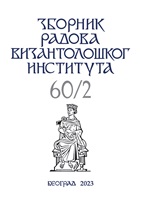СИРМИЈУМ И ОБЛАСТ ДРУГЕ ПАНОНИЈЕ У VI И VII ВЕКУ У СВЕТЛУ НОВИХ НАЛАЗА
SIRMIUM AND THE REGION OF PANNONIA SECUNDA IN THE SIXTH AND SEVENTH CENTURIES IN LIGHT OF NEW FINDS
Author(s): Ivan Bugarski, Vujadin IvaniševićSubject(s): Archaeology, Cultural history, Social history, 6th to 12th Centuries
Published by: Vizantološki institut SANU
Keywords: Sirmium; Pannonia Secunda; sixth and seventh centuries; Romans; Germans; Avars; archaeological finds;
Summary/Abstract: The fall of Sirmium under the Avars in 582 marks the end of a long process of weakening of imperial power on the Danube border. The Hunnic incursions of the mid-fifth century had left permanent economic and demographic consequences, crucial to the fate of northern possessions. The region of Pannonia Secunda, with the capital Sirmium, became the prey of Germanic populations, Ostrogoths and Gepids. By the beginning of the sixth century, Byzantium controlled only the eastern part of Syrmia with the city of Bassianae, where the Heruli were settled. The Germanic newcomers left recognisable material traces, particularly in Sirmium and Cibalae. Even in the context of depopulation and ruralisation of these centres, traces of the persisting Romans can also be observed. After the 567 Avar victory over the Gepids, the Empire managed to regain control of Sirmium; fierce battles and negotiations were to end only with the fall of the city. Judging by the archaeological record, the Avars seem not to have settled Syrmia, or Sirmium itself, on a large scale. There is numismatic, sigillographic and archaeological evidence for the period of the fall of Pannonia Secunda and for the following decades in which the Romans went on living under conditions far from ideal. In this paper we publish Byzantine lead seals, the most important of which bears the name of θεμι(σ)τός τοῦ Ἀβαρικοῦ. By all appearances, it belonged to a diplomat dealing with the Avars between 567 and 582, although a slightly later dating is possible, as well. The well-known belt-set from Divoš (?), certainly of Byzantine make, is likewise discussed in the light of diplomatic relations and tribute. We also publish a matrix for hammering out the Martynovka-type harness mounts and a belt buckle of the so-called Pannonian type. While it is not possible to conclude whether these objects belonged to the remaining Romans or not, they apparently reflect cultural affinities in Avar Syrmia and the strength of Byzantine influences.
Journal: Зборник радова Византолошког института
- Issue Year: 2023
- Issue No: 60/2
- Page Range: 669-693
- Page Count: 25
- Language: Serbian

